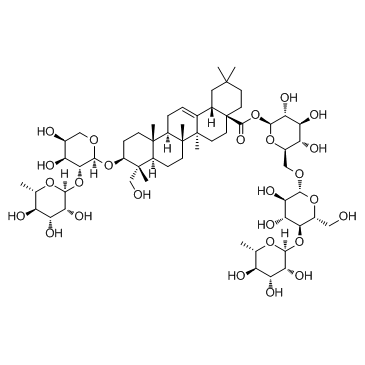Kalopanaxsaponins A and B isolated from Kalopanax pictus ameliorate memory deficits in mice.
Eun-Ha Joh, In-Ah Lee, Dong-Hyun Kim
Index: Phytother Res. 26(4) , 546-51, (2012)
Full Text: HTML
Abstract
The stem-bark of Kalopanax pictus (KP, family Araliaceae), which contains triterpenoid saponins, has been shown to exhibit anticarcinogenic, antiinflammatory, antirheumatoid and antidiabetic activities. In a preliminary study, a KP methanol extract demonstrated acetylcholinesterase activity in vitro and memory enhancement in scopolamine-treated mice. Therefore, we isolated acetylcholinesterase inhibitors, kalopanaxsaponins A and B, from a KP butanol (BuOH) fraction, measured acetylcholinesterase activity in vitro, and investigated their memory-enhancing effects in a passive avoidance test, Y-maze test and Morris water maze test. These constituents inhibited acetylcholinesterase activity and significantly reversed scopolamine-induced deficits. They also increased brain-derived neurotrophic factor (BDNF) and phosphorylated cAMP response element binding (p-CREB) protein expression but reduced TNF-α increased by scopolamine. Based on these findings, kalopanaxsaponins A and B may ameliorate memory deficits by inhibiting acetylcholinesterase activity and inducing BDNF and p-CREB expression.Copyright © 2011 John Wiley & Sons, Ltd.
Related Compounds
| Structure | Name/CAS No. | Molecular Formula | Articles |
|---|---|---|---|
 |
Hederacoside C
CAS:14216-03-6 |
C59H96O26 |
|
[Studies on the saponin constituents of Kalopanax septemlobu...
1990-01-01 [Yao Xue Xue Bao 25(1) , 29-34, (1990)] |
|
Triterpenoidal saponins from the bark of Kalopanax pictum va...
1991-03-01 [Arch. Pharm. Res. 14(1) , 19-24, (1991)] |
|
Antinociceptive and anti-rheumatoidal effects of Kalopanax p...
2002-02-01 [J. Ethnopharmacol. 79(2) , 199-204, (2002)] |
|
Kalopanaxsaponin A from Kalopanax pictus, a potent antioxida...
2002-01-01 [J. Ethnopharmacol. 79(1) , 113-8, (2002)] |
|
Metabolism of kalopanaxsaponin B and H by human intestinal b...
1998-04-01 [Biol. Pharm. Bull. 21(4) , 360-5, (1998)] |